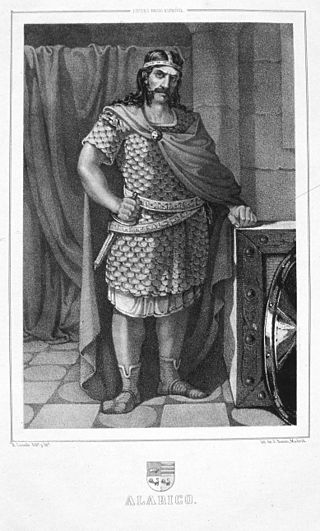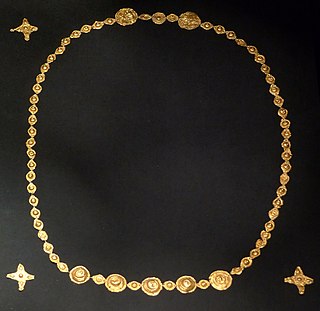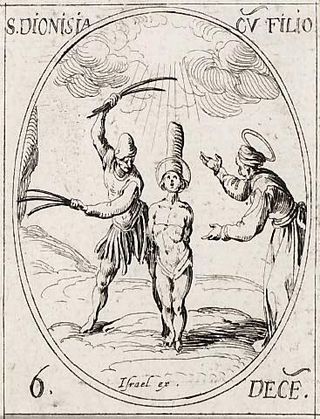Saints Victorian, Frumentius and Companions | |
|---|---|
| Martyrs | |
| Died | March 23, 484 AD Hadrumetum, North Africa |
| Venerated in | Roman Catholic Church |
| Feast | March 23 |
Victorian, Frumentius and Companions are venerated as Christian martyrs of the Roman Catholic Church. They were killed at Hadrumetum in 484 by the Arian Vandals. Accounts of their martyrdom state that Huneric, King of the Vandals, began persecuting Catholic priests and virgins in 480, and by 484 began persecuting simple believers as well. Victorian was a wealthy Catholic of Hadrumetum who had been appointed proconsul by Hunneric. He served as an obedient administrator to the king until he was asked to convert to Arianism. Victorian refused and was tortured and killed.
The Roman Martyrology states that four other wealthy merchants were martyred on the same day as Victorian's death. Two were named Frumentius; they were merchants of Carthage. The other two were brothers of the city of Aquae Regiae, Byzacena, who were killed at Tabaia.

Huneric,Hunneric or Honeric was King of the Vandal Kingdom (477–484) and the oldest son of Gaiseric. He abandoned the imperial politics of his father and concentrated mainly on internal affairs. He was married to Eudocia, daughter of western Roman Emperor Valentinian III (419–455) and Licinia Eudoxia. The couple had one child, a son named Hilderic.
The 480s decade ran from January 1, 480, to December 31, 489.

Year 484 (CDLXXXIV) was a leap year starting on Sunday of the Julian calendar. At the time, it was known as the Year of the Consulship of Venantius and Theodoricus. The denomination 484 for this year has been used since the early medieval period, when the Anno Domini calendar era became the prevalent method in Europe for naming years.

The Vandals were a Germanic people who first inhabited what is now southern Poland. They established Vandal kingdoms on the Iberian Peninsula, Mediterranean islands, and North Africa in the fifth century.
Pope Felix III was the bishop of Rome from 13 March 483 to his death. His repudiation of the Henotikon is considered the beginning of the Acacian schism. He is commemorated on March 1.

Frumentius was a Phoenician Christian missionary and the first bishop of Axum who brought Christianity to the Kingdom of Aksum. He is sometimes known by other names, such as Abuna and Aba Salama.

Hadrumetum, also known by many variant spellings and names, was a Phoenician colony that pre-dated Carthage. It subsequently became one of the most important cities in Roman Africa before Vandal and Umayyad conquerors left it ruined. In the early modern period, it was the village of Hammeim, now part of Sousse, Tunisia.

March 22 - Eastern Orthodox liturgical calendar - March 24
Alban of Mainz was a Catholic priest, missionary, and martyr in the Late Roman Empire. He is venerated as Saint Alban of Mainz in the Catholic Church, not to be confused with Saint Alban of Verulamium.

Thelepte was a city in the Roman province of Byzacena, now in western Tunisia. It is located near the border with Algeria about 5 km north from the modern town of Fériana and 30 km south-west of the provincial capital Kasserine.
Gothic Christianity refers to the Christian religion of the Goths and sometimes the Gepids, Vandals, and Burgundians, who may have used the translation of the Bible into the Gothic language and shared common doctrines and practices.

Saint Eugenius of Carthage was a Christian saint, unanimously elected Bishop of Carthage in 480 to succeed Deogratias. He was caught up in the disputes of his day between Arianism and mainstream Christianity.

Saint Aquilinus of Milan, also known as Aquilinus of Cologne, is venerated as a martyr by the Catholic Church.
The Notitia provinciarum et civitatum Africae is a Byzantine-era document listing the bishops and sees in the Roman provinces of North Africa, Sardinia and the Balearics. The cause of its preparation was the council of Carthage held on 1 February 484 by the Arian king of the Vandals, Huneric (477–484).

Denise, Dativa, Leontia, Tertius, Emilianus, Boniface, Majoricus, and Servus are venerated as martyrs by the Catholic Church. They were killed in the late 5th century during the persecution of Trinitarian Christians in Proconsular Africa by the Arian Vandals, according to Victor of Vita. These martyrs were killed during the reign of Arian king Hunneric.
Quintian (Quinctianus), Lucius and Julian (Julianus) are venerated as saints and martyrs by the Roman Catholic Church. According to the Roman Martyrology, they were inhabitants of North Africa who were killed during the persecutions of the Vandal king Huneric, who was an Arian. However, the date of their martyrdom may be conjectural. They are the only ones named in a group of sixteen martyrs, which included several women.

The Vandal Kingdom or Kingdom of the Vandals and Alans was a confederation of Vandals and Alans, which was a barbarian kingdom established under Gaiseric, a Vandalic warlord. It ruled parts of North Africa and the Mediterranean for 99 years from 435 to 534 AD.
Saint Felix of Hadrumetum was a North African Catholic bishop. He was bishop of Hadrumetum, the current Sousse in Tunisia. and died as a martyr during the persecution by the king of the Vandals, Genseric, who was supporter of Arianism. His feast day is February 21.

Vita was a Roman–Berber civitas in Africa Proconsularis. It is a former Christian diocese and Latin Catholic titular see.
Arcadius, Paschasius, Probus and Eutychius were Chalcedonian Christian martyrs. Natives of Hispania, they became loyal counsellors of the Vandal king Gaiseric, but were ultimately proscribed, exiled, tortured and executed in 437 for refusing the king's command to convert to Arianism. Their story is recounted in the contemporary chronicle of Prosper of Aquitaine. Paschasius and Eutychius, whose name is sometimes given as Eutychian, were brothers.